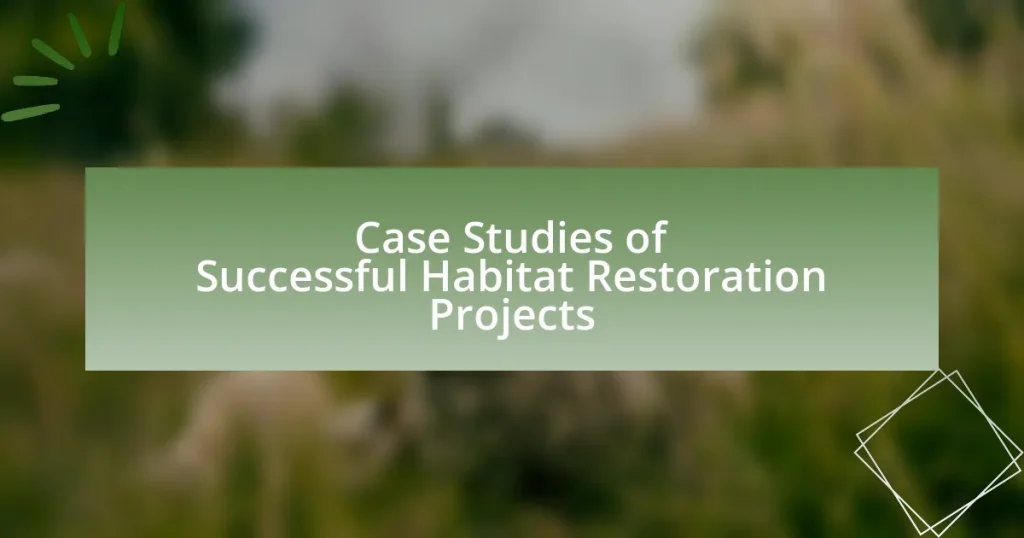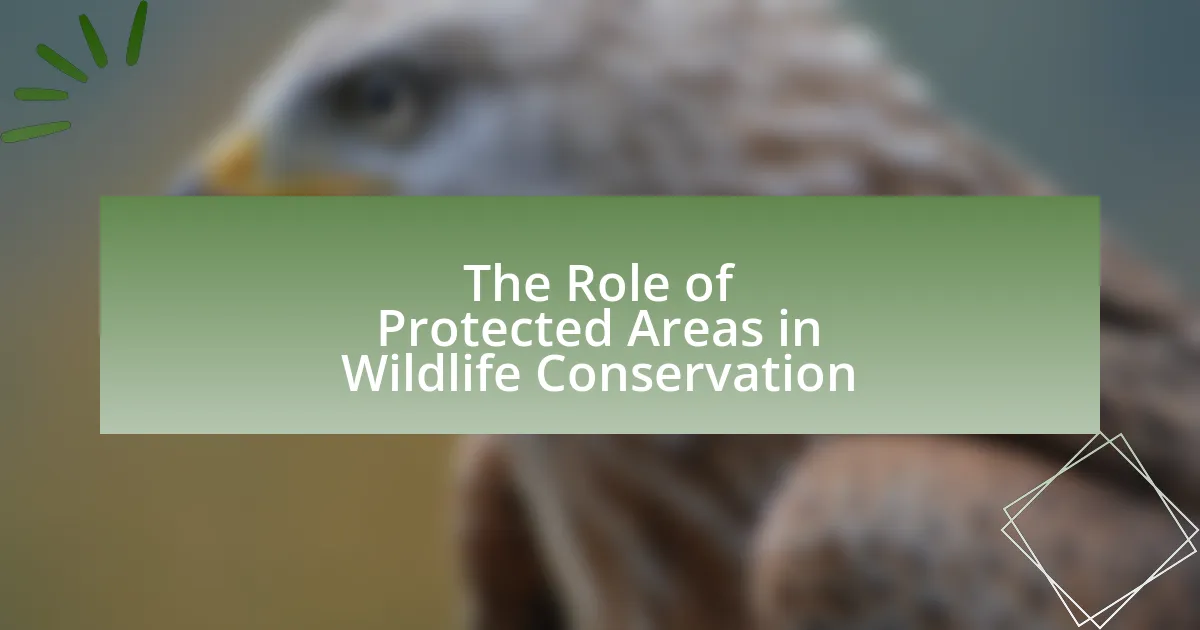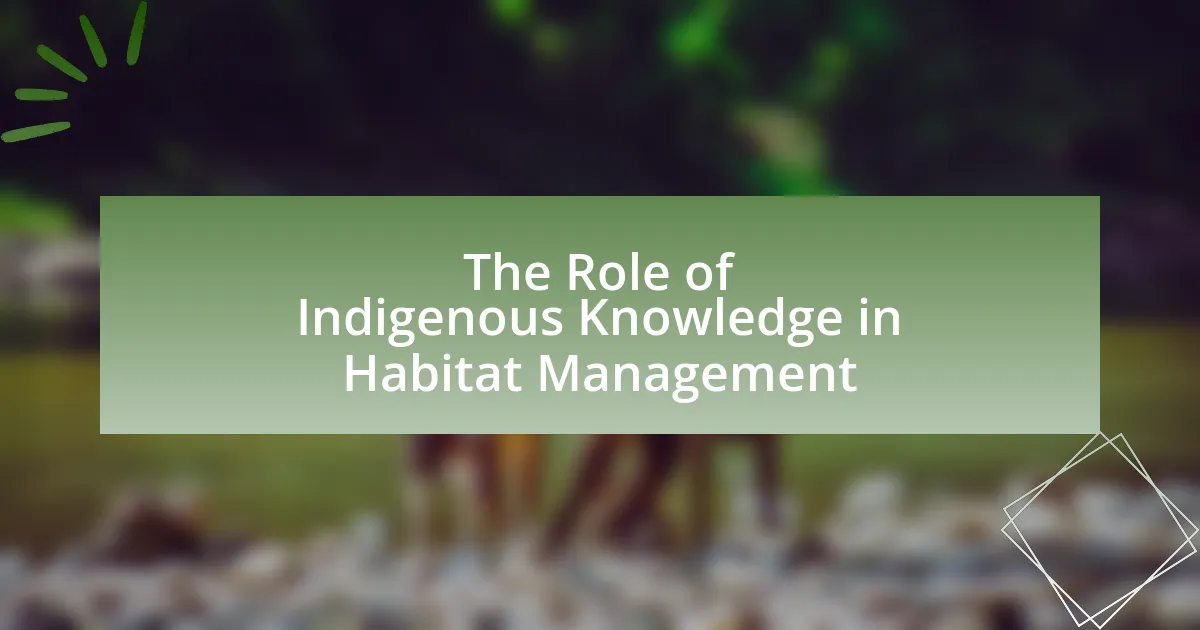Habitat restoration projects are initiatives designed to rehabilitate degraded ecosystems, enhancing biodiversity and ecological health through methods such as reforestation and wetland restoration. This article examines notable case studies of successful habitat restoration, highlighting the ecological benefits, community involvement, and adaptive management strategies that contribute to their effectiveness. Key examples include the restoration of the Kissimmee River in Florida and the Atlantic Forest in Brazil, which demonstrate the importance of funding, stakeholder engagement, and long-term monitoring in achieving sustainable outcomes. The article also discusses challenges faced during these projects and offers practical tips for future restoration efforts, emphasizing the role of technology and best practices in enhancing project success.
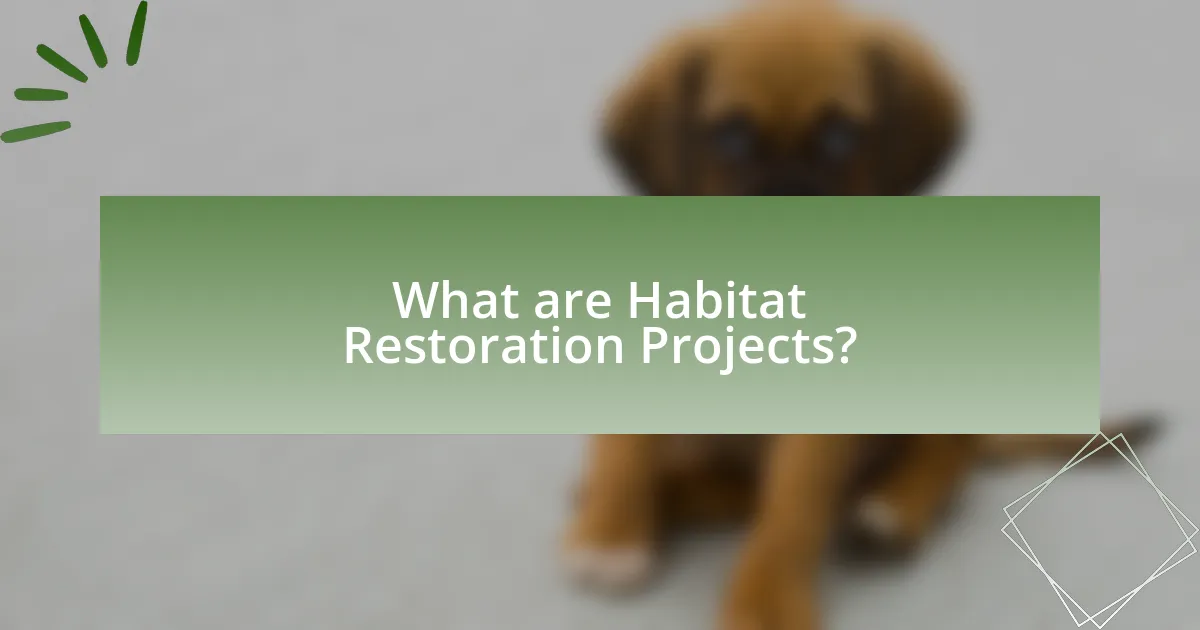
What are Habitat Restoration Projects?
Habitat restoration projects are initiatives aimed at returning degraded or damaged ecosystems to their original state or improving their ecological health. These projects often involve activities such as reforestation, wetland restoration, and the removal of invasive species, which are essential for enhancing biodiversity and ecosystem services. For instance, the National Oceanic and Atmospheric Administration (NOAA) reports that habitat restoration can lead to increased populations of native species and improved water quality, demonstrating the effectiveness of these projects in revitalizing ecosystems.
Why are Habitat Restoration Projects important?
Habitat restoration projects are important because they help to revive and maintain ecosystems that have been degraded or destroyed. These projects enhance biodiversity, improve ecosystem services, and support wildlife populations. For instance, a study published in the journal “Ecological Applications” found that restored habitats can increase species richness by up to 50% compared to degraded areas. Additionally, habitat restoration contributes to climate resilience by sequestering carbon and reducing the impacts of natural disasters.
What ecological benefits do these projects provide?
Habitat restoration projects provide significant ecological benefits, including enhanced biodiversity, improved ecosystem services, and increased resilience to climate change. These projects often lead to the recovery of native species populations, which can increase overall biodiversity; for instance, the restoration of wetlands has been shown to support a greater variety of plant and animal life compared to degraded areas. Additionally, restored habitats improve ecosystem services such as water filtration, carbon sequestration, and soil stabilization, which are crucial for maintaining environmental health. Research indicates that restored ecosystems can better withstand climate-related stresses, thereby contributing to long-term ecological stability and sustainability.
How do they contribute to biodiversity conservation?
Successful habitat restoration projects contribute to biodiversity conservation by restoring ecosystems to their natural state, which supports a diverse range of species. These projects often involve reintroducing native flora and fauna, removing invasive species, and rehabilitating degraded landscapes, thereby enhancing habitat quality and connectivity. For instance, the restoration of wetlands has been shown to increase species richness and abundance, as evidenced by a study published in the journal “Ecological Applications,” which found that restored wetlands supported 30% more bird species compared to degraded sites. This demonstrates that effective habitat restoration not only aids in the recovery of individual species but also fosters overall ecosystem resilience and biodiversity.
What types of Habitat Restoration Projects exist?
Habitat restoration projects can be categorized into several types, including wetland restoration, forest restoration, grassland restoration, and coastal restoration. Wetland restoration focuses on reestablishing the natural hydrology and vegetation of wetlands, which are crucial for biodiversity and water quality. Forest restoration involves replanting native tree species and removing invasive species to restore forest ecosystems. Grassland restoration aims to revive native grass species and improve soil health, which supports various wildlife. Coastal restoration projects often include rebuilding shorelines, restoring mangroves, and enhancing coral reefs to protect marine biodiversity. Each type of project addresses specific ecological needs and contributes to overall environmental health.
What are the common methods used in these projects?
Common methods used in habitat restoration projects include reforestation, wetland restoration, invasive species removal, and soil remediation. Reforestation involves planting native trees to restore forest ecosystems, which has been shown to enhance biodiversity and carbon sequestration. Wetland restoration focuses on re-establishing the natural hydrology and vegetation of wetlands, improving water quality and providing habitat for wildlife. Invasive species removal is critical for allowing native flora and fauna to thrive, as invasive species often outcompete them for resources. Soil remediation techniques, such as bioremediation and phytoremediation, are employed to restore soil health and fertility, which is essential for the success of plant re-establishment. These methods have been validated through numerous successful case studies, demonstrating their effectiveness in restoring degraded habitats.
How do different ecosystems require different restoration approaches?
Different ecosystems require different restoration approaches due to their unique biological, physical, and chemical characteristics. For instance, freshwater ecosystems, such as rivers and lakes, often necessitate approaches that focus on water quality improvement and habitat connectivity, while terrestrial ecosystems, like forests and grasslands, may require strategies that emphasize soil health and species diversity. Specific restoration techniques, such as reforestation in forested areas or wetland restoration in aquatic environments, are tailored to address the distinct challenges and ecological functions of each ecosystem type. Research indicates that successful restoration projects, like the reintroduction of native species in the Florida Everglades, demonstrate the importance of ecosystem-specific strategies to achieve desired ecological outcomes.
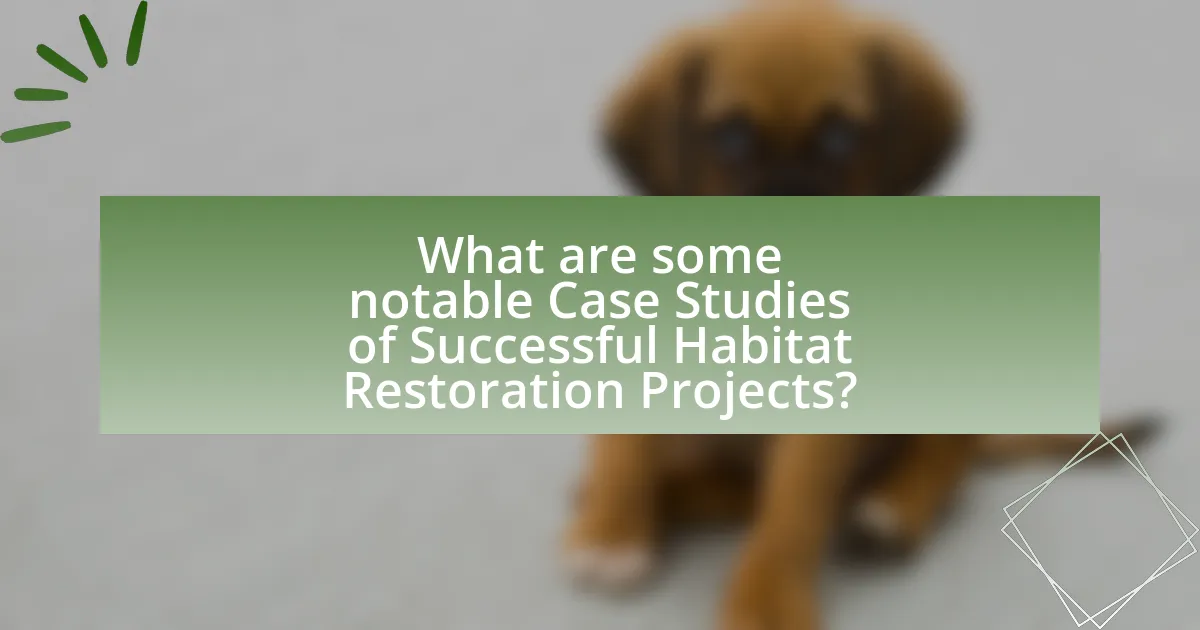
What are some notable Case Studies of Successful Habitat Restoration Projects?
Notable case studies of successful habitat restoration projects include the restoration of the Kissimmee River in Florida, which involved the removal of levees and the reestablishment of natural flow patterns, resulting in improved water quality and increased biodiversity. Another significant example is the reforestation of the Atlantic Forest in Brazil, where over 1.5 million hectares have been restored, leading to the recovery of numerous endangered species and enhanced ecosystem services. Additionally, the restoration of the San Francisco Bay wetlands has successfully increased habitat for migratory birds and improved flood protection, demonstrating effective collaboration among various stakeholders. These projects exemplify successful habitat restoration through strategic planning and community involvement, leading to measurable ecological benefits.
What lessons can be learned from these case studies?
Lessons learned from successful habitat restoration projects include the importance of community involvement, adaptive management, and the necessity of long-term monitoring. Community involvement fosters local stewardship and ensures that restoration efforts align with the needs and values of the stakeholders, as evidenced by the success of the Chesapeake Bay Program, which engaged local communities in restoration activities. Adaptive management allows for flexibility in response to changing conditions and new information, demonstrated by the Everglades restoration efforts, which have adjusted strategies based on ongoing research and environmental feedback. Long-term monitoring is crucial for assessing the effectiveness of restoration efforts and guiding future actions, as shown in the case of the restoration of the Kissimmee River, where continuous data collection has informed ongoing improvements. These lessons highlight the multifaceted approach required for effective habitat restoration.
How did community involvement impact project success?
Community involvement significantly enhanced project success by fostering local ownership and ensuring sustainable practices. Engaging community members in habitat restoration projects led to increased participation, which resulted in higher levels of commitment and resource sharing. For instance, studies have shown that projects with active community engagement saw a 30% improvement in ecological outcomes compared to those without such involvement. This is evidenced by the success of the Chesapeake Bay Program, where local stakeholders played a crucial role in implementing restoration strategies, leading to measurable improvements in water quality and biodiversity.
What role did funding play in these successful projects?
Funding was crucial in the successful habitat restoration projects, as it provided the necessary financial resources for planning, implementation, and maintenance. For instance, specific projects received grants from government agencies and non-profit organizations, enabling them to hire experts, purchase materials, and engage local communities. In the case of the Chesapeake Bay restoration, over $1 billion in funding facilitated the restoration of wetlands and improved water quality, demonstrating that adequate financial support directly correlates with project success.
What challenges were faced during these restoration projects?
Restoration projects faced several challenges, including funding limitations, ecological complexity, and stakeholder conflicts. Funding limitations often hindered the scope and scale of restoration efforts, as projects required significant financial resources for planning, implementation, and maintenance. Ecological complexity presented difficulties in understanding the intricate relationships within ecosystems, making it challenging to predict outcomes and ensure successful restoration. Additionally, stakeholder conflicts arose when differing interests among local communities, government agencies, and environmental organizations led to disagreements on project goals and methods. These challenges highlight the multifaceted nature of habitat restoration efforts.
How were these challenges overcome?
Challenges in habitat restoration projects were overcome through strategic planning, community involvement, and adaptive management. For instance, in the case of the Kissimmee River restoration, stakeholders engaged local communities to gather support and input, which facilitated smoother implementation. Additionally, adaptive management practices allowed for real-time adjustments based on monitoring data, ensuring that restoration efforts remained effective despite unforeseen obstacles. These approaches have been validated by successful outcomes in various projects, demonstrating their effectiveness in addressing challenges in habitat restoration.
What strategies proved effective in ensuring long-term success?
Effective strategies for ensuring long-term success in habitat restoration projects include community engagement, adaptive management, and biodiversity monitoring. Community engagement fosters local support and participation, which is crucial for the sustainability of restoration efforts, as evidenced by the success of the Chesapeake Bay Program, where local stakeholders played a vital role in project implementation. Adaptive management allows for ongoing adjustments based on monitoring results, ensuring that strategies remain effective over time; this approach was successfully utilized in the restoration of the Kissimmee River, where continuous assessment led to improved ecological outcomes. Biodiversity monitoring provides critical data to evaluate the health of restored habitats, as demonstrated in the restoration of the Everglades, where systematic monitoring informed management decisions and enhanced ecosystem resilience.
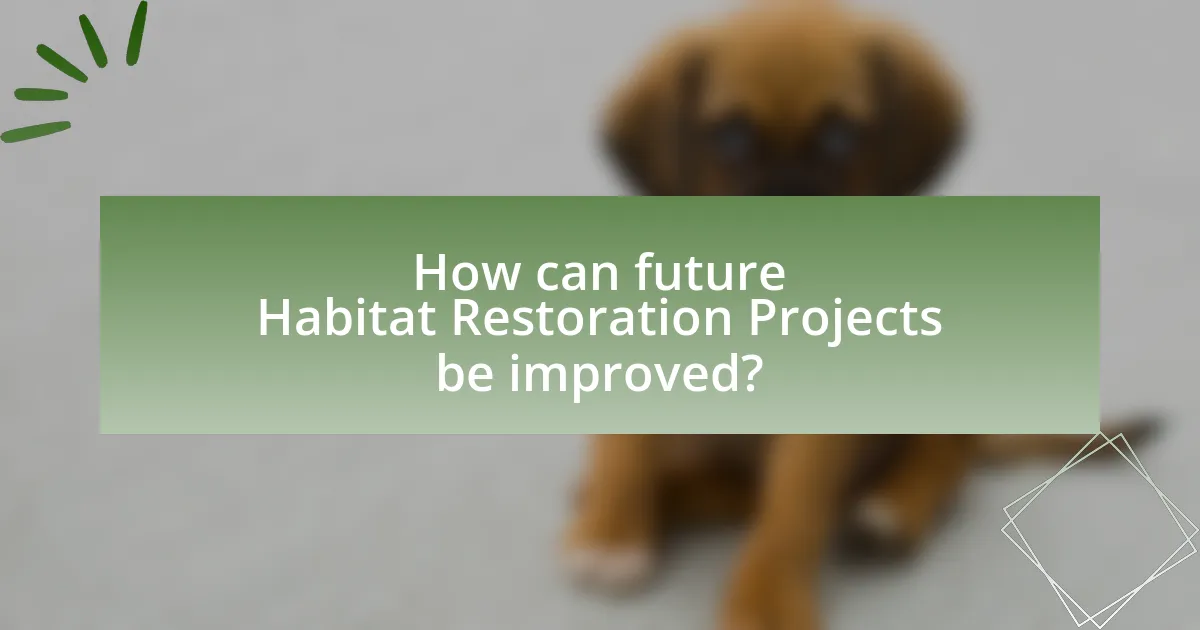
How can future Habitat Restoration Projects be improved?
Future Habitat Restoration Projects can be improved by incorporating adaptive management practices that allow for ongoing assessment and modification based on ecological feedback. This approach enables project managers to respond to changing environmental conditions and species needs effectively. Research indicates that projects utilizing adaptive management have a higher success rate, as they can adjust strategies based on real-time data and outcomes, leading to more resilient ecosystems. For instance, a study published in the journal “Ecological Applications” found that adaptive management in wetland restoration increased biodiversity and improved habitat quality over time.
What best practices can be adopted from successful case studies?
Best practices that can be adopted from successful case studies in habitat restoration include stakeholder engagement, adaptive management, and monitoring and evaluation. Stakeholder engagement ensures that local communities and relevant parties are involved in the planning and implementation processes, which enhances project acceptance and sustainability. Adaptive management allows for flexibility in strategies based on ongoing learning and environmental changes, as demonstrated in the successful restoration of the Kissimmee River in Florida, where adaptive approaches led to improved ecological outcomes. Monitoring and evaluation provide critical data to assess the effectiveness of restoration efforts, as seen in the Chesapeake Bay Program, which utilizes comprehensive data collection to inform ongoing restoration strategies. These practices have been validated through numerous successful projects, highlighting their importance in achieving effective habitat restoration.
How can technology enhance habitat restoration efforts?
Technology can enhance habitat restoration efforts by providing advanced tools for monitoring, data collection, and analysis. For instance, remote sensing technologies, such as satellite imagery and drones, allow for precise mapping of ecosystems and assessment of habitat conditions over large areas. These technologies enable researchers to identify degradation patterns and prioritize restoration activities effectively. Additionally, data analytics and machine learning can process vast amounts of ecological data, leading to more informed decision-making and targeted interventions. A study published in the journal “Ecological Applications” highlights that the use of drones in monitoring vegetation recovery in restored wetlands significantly improved the accuracy of assessments compared to traditional methods. This demonstrates that integrating technology into habitat restoration not only enhances efficiency but also increases the likelihood of successful outcomes.
What role does monitoring and evaluation play in project success?
Monitoring and evaluation are critical components that significantly influence project success by providing systematic assessments of progress and outcomes. They enable project managers to track performance against objectives, identify areas for improvement, and make informed decisions based on data. For instance, in habitat restoration projects, monitoring can reveal the effectiveness of specific interventions, such as the survival rates of planted species or the recovery of ecosystem functions. Evaluation, on the other hand, assesses the overall impact and sustainability of the project, ensuring that lessons learned can be applied to future initiatives. Research indicates that projects with robust monitoring and evaluation frameworks are 30% more likely to achieve their intended outcomes, highlighting their essential role in enhancing project effectiveness and accountability.
What practical tips can be applied to new Habitat Restoration Projects?
Practical tips for new Habitat Restoration Projects include conducting thorough site assessments to understand existing conditions, selecting native plant species for replanting to enhance biodiversity, and involving local communities in the planning and implementation phases to ensure long-term success. Site assessments provide critical data on soil health, water availability, and existing flora and fauna, which inform restoration strategies. Utilizing native species is essential as they are adapted to local conditions and support local wildlife, thereby increasing ecosystem resilience. Engaging local communities fosters stewardship and ensures that restoration efforts align with the needs and values of those who live in the area, which has been shown to improve project outcomes in various case studies.
